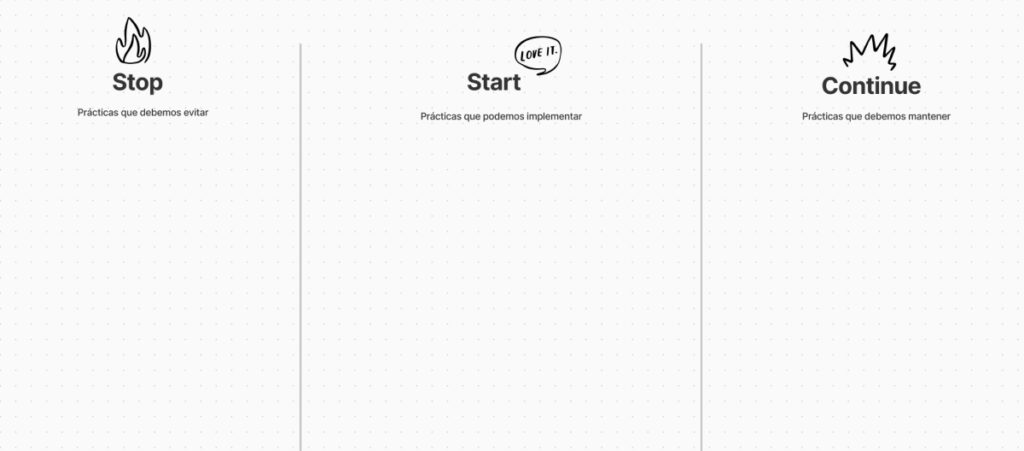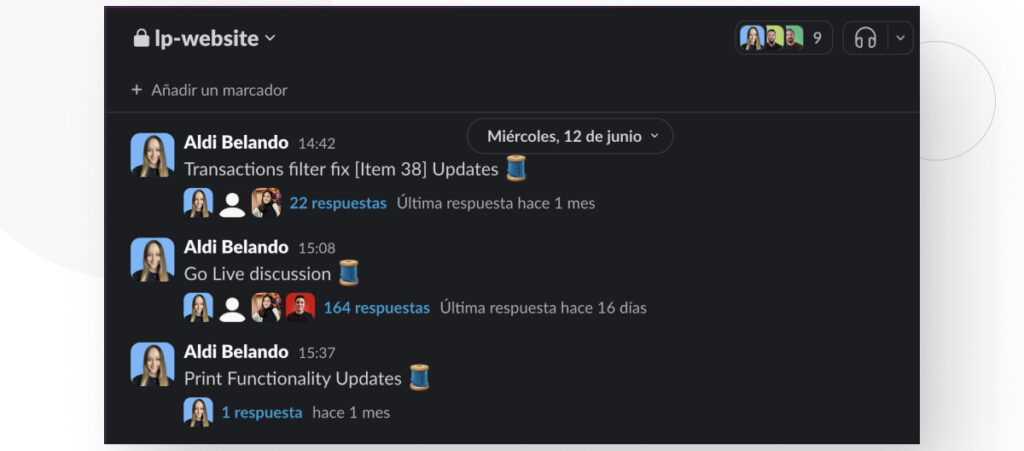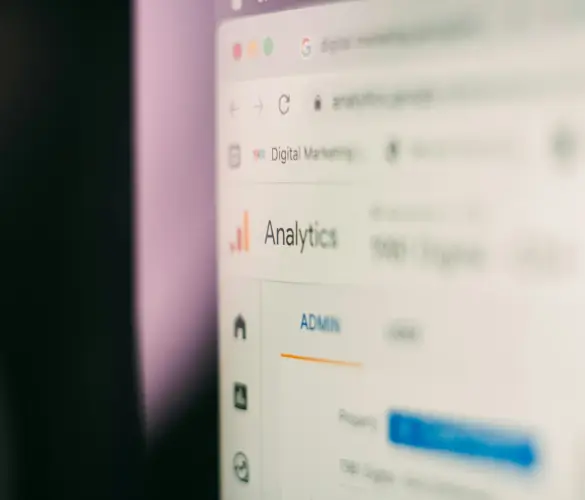- Blogs
- Detrás del Lienzo
- Cómo adaptamos las metodologías Ágiles para satisfacer las necesidades de nuestros clientes
Detrás del Lienzo / 9 min de lectura
Cómo adaptamos las metodologías Ágiles para satisfacer las necesidades de nuestros clientes

En White Canvas, hemos adoptado los principios ágiles y los hemos adaptado a las necesidades únicas de nuestra agencia.
Al implementar ciclos ágiles y añadir nuevos procesos para satisfacer las necesidades de nuestros clientes, garantizamos la eficiencia y efectividad de nuestras operaciones, lo que nos permite ofrecer resultados de alta calidad a nuestros clientes.
A continuación, te mostramos cómo hemos personalizado las metodologías ágiles para mejorar nuestro flujo de trabajo y comunicación.
¿Qué son las Metodologías Ágiles en el Desarrollo de WordPress?
Las metodologías ágiles son un conjunto de prácticas y principios destinados a mejorar el proceso de desarrollo web haciéndolo más flexible, colaborativo y centrado en el cliente.
Creadas en 2001, las metodologías ágiles se diferencian de la gestión de proyectos de desarrollo web tradicional al enfatizar ciclos de desarrollo iterativos, donde los requisitos y soluciones evolucionan a través del esfuerzo colaborativo de equipos multifuncionales.
Aquí están los aspectos clave de las metodologías ágiles en el desarrollo web:
- Desarrollo iterativo: Los proyectos se descomponen en unidades pequeñas y manejables llamadas iteraciones o sprints, que generalmente duran de 1 a 4 semanas.
- Colaboración y comunicación: Agile enfatiza una fuerte colaboración entre los miembros del equipo y las partes interesadas a través de reuniones diarias rápidas, revisiones regulares de sprints y retrospectivas.
- Centrado en el cliente: Las metodologías ágiles priorizan la satisfacción del cliente involucrándolos en el proceso de desarrollo mediante retroalimentación regular.
- Flexibilidad y adaptabilidad: Los equipos ágiles deben ser receptivos a los cambios en los requisitos, incluso en etapas avanzadas del proceso de desarrollo.
- Mejora continua: Agile fomenta la mejora continua a través de la reflexión regular sobre los procesos y prácticas. Los equipos identifican áreas de mejora e implementan cambios para aumentar productividad y calidad.
Beneficios de Agile para los Clientes
Al utilizar metodologías ágiles para nuestros proyectos de desarrollo de WordPress, ofrecemos los siguientes beneficios a nuestros clientes.
- Tiempos de entrega más rápidos: La naturaleza iterativa de Agile nos permite entregar componentes del proyecto gradualmente a un ritmo constante. Esto significa que los clientes ven resultados temprano en la línea de tiempo del proyecto en lugar de esperar por un producto final.
- Entregables de mayor calidad: Las revisiones regulares, demostraciones internas y las vueltas de retroalimentación de los clientes aseguran que el producto final cumpla con los altos estándares que nuestros clientes esperan de nosotros.
- Mayor transparencia: Llamadas semanales y acceso abierto a tableros de proyectos mantienen a los clientes informados y involucrados durante todo el proyecto.
- Más participación del cliente: Los clientes pueden unirse a nuestros tableros de Asana para monitorear el progreso diario, dejar comentarios y aportar en los entregables. Las llamadas semanales y las demostraciones internas ofrecen múltiples puntos de contacto para que los clientes compartan sus ideas y preferencias, llevando a un producto final que verdaderamente se alinea con sus necesidades y expectativas.
- Flexibilidad y adaptabilidad: El marco flexible de Agile nos permite adaptarnos rápidamente a los cambios. Si las prioridades cambian o surgen nuevos requisitos, nuestro equipo puede ajustar el plan del proyecto durante las revisiones de sprint y las llamadas diarias.
Nuestra Misión y el Rol de las Metodologías Ágiles
En White Canvas, apuntamos a crear soluciones excepcionales y de alta calidad en desarrollo de WordPress. Nuestro objetivo a largo plazo es convertirnos en un líder en desarrollo de WordPress colocando la excelencia al frente de nuestros servicios para hacer una diferencia en cada proyecto.
Las metodologías ágiles nos proporcionan el marco necesario para entregar software de alta calidad de la manera más eficiente posible. Nuestra búsqueda de eficiencia nos llevó a adoptar Agile, pero también a buscar aún más formas de mejorar nuestras operaciones.
Como resultado, necesitamos ajustar las metodologías ágiles para que nuestros procesos se adapten aún mejor a las necesidades de nuestros clientes.
Personalizando Agile para Nuestra Agencia
Hemos adoptado la mayoría de los principios centrales de Agile pero hemos realizado ajustes estratégicos para adecuarlos mejor a nuestras operaciones. Un enfoque personalizado nos permite mantener la flexibilidad y capacidad de respuesta que Agile promueve y al mismo tiempo atender las necesidades específicas de nuestros proyectos y clientes.
Así es como se ven nuestras metodologías ágiles.
Llamadas Diarias con Miembros del Equipo
Las llamadas diarias son un elemento crucial de nuestro proceso ágil. Estas reuniones cortas mantienen a nuestro equipo conectado, permitiéndonos discutir problemas inmediatos y asegurándonos de que todos tengan claro sus tareas y plazos.
Al promover una comunicación abierta, podemos resolver rápidamente cualquier obstáculo y mantener nuestros proyectos en curso. Si surgen cambios o nuevas prioridades, nuestras reuniones diarias permiten ajustar prioridades y mantener la flexibilidad mientras alcanzamos nuestros objetivos del proyecto.

Sprints de 2 Semanas
Nuestro trabajo se organiza en sprints de 2 semanas: períodos cortos y focalizados donde nos concentramos en tareas específicas y entregables. Esta estructura de sprints nos permite descomponer grandes proyectos en partes manejables, asegurando un progreso constante y la entrega continua de valor.
Al final de cada sprint, realizamos una reunión interna de demostración para revisar los entregables antes de las revisiones semanales con nuestros clientes.
Demos Internas
Priorizamos la entrega de resultados de alta calidad a nuestros clientes. Para lograr esto, hemos incorporado reuniones de demostración interna en nuestro proceso ágil. Estas reuniones juegan un papel vital en nuestro flujo de trabajo, permitiéndonos revisar los entregables de los sprints antes de nuestra revisión semanal con los clientes.
Las reuniones de demostración interna sirven como un punto de control para garantizar que el trabajo completado durante el sprint cumpla con nuestros estándares de calidad. Durante estas sesiones, nuestro equipo revisa los entregables, ofrece retroalimentación y realiza los ajustes necesarios.
Algunos detalles clave de estas reuniones incluyen:
- Entornos de staging: La demo se lleva a cabo en entornos de staging, reflejando las condiciones de una presentación real al cliente. Mientras que un entorno DEV se utiliza para pruebas, el entorno de staging se prepara específicamente para presentaciones a clientes.
- Precisión de datos: Aseguramos que todas las entradas de datos sean precisas, replicando las condiciones del sistema en vivo.
- Demo lista para clientes: La demo se realiza como si fuera una presentación al cliente, por lo que no se muestran tareas parciales o incompletas durante esta demo interna. Refleja el progreso del proyecto tal como se presentaría a un cliente.
Este enfoque proactivo nos ayuda a identificar y abordar problemas potenciales antes de presentar los resultados a nuestros clientes.
Llamadas Semanales con Clientes
Ya que la comunicación con los clientes es un pilar del proceso ágil, programamos llamadas semanales con nuestros clientes para mantenerlos informados sobre el avance de sus proyectos. Durante las reuniones, presentamos el proyecto al cliente, proporcionándoles una vista completa del progreso realizado durante el sprint.
Las reuniones semanales nos ayudan a alinear expectativas, abordar preocupaciones y asegurarnos de que siempre estamos en la misma página, ayudándonos a construir confianza con los clientes y fomentar relaciones fuertes y colaborativas.
Reuniones Retrospectivas del Proyecto
Al final de cada proyecto, realizamos una reunión retrospectiva interna con nuestro equipo para reflexionar sobre lo que salió bien e identificar áreas de mejora. Estas reuniones nos ayudan a mejorar continuamente nuestros procesos y la calidad de nuestro trabajo al evaluar nuestro desempeño y hacer los ajustes necesarios.
Cómo Funcionan las Reuniones Retrospectivas
En cada reunión, nos reunimos para listar las acciones que creemos que deberíamos dejar de hacer, las acciones que deberíamos comenzar a hacer y las acciones que deberíamos continuar haciendo para mejorar nuestros proyectos de desarrollo de WordPress.
Cada reunión retrospectiva debe:
- Revisar éxitos: Discutimos qué funcionó bien para identificar estrategias efectivas.
- Identificar desafíos: Identificamos cualquier obstáculo y sus causas.
- Recopilar retroalimentación: Los miembros del equipo comparten ideas y sugerencias.
- Planear acciones concretas: Creamos una lista de pasos para mejorar nuestros procesos para proyectos futuros.

Nuestras Herramientas: Asana y Slack
La gestión eficiente de proyectos y la comunicación son vitales para nuestro éxito. Aquí es cómo aprovechamos Asana y Slack para optimizar nuestras operaciones.
Asana para la Gestión de Tareas
Usamos Asana para gestionar nuestros proyectos y rastrear actualizaciones. Nos proporciona todo lo que necesitamos para organizar tareas, establecer plazos y monitorear el progreso en tiempo real.
Invitamos a nuestros clientes a unirse a nuestros tableros de Asana, brindándoles visibilidad sobre el progreso diario y fomentando un sentido de participación en el proyecto, ya que también pueden dejar comentarios en cada tarea.
Los tableros de Asana sirven como el centro central para gestionar tareas y actividades relacionadas con el proyecto. Aquí está por qué son esenciales:
- Visualización: Los tableros de Asana proporcionan una visión general visual de las tareas, lo que facilita entender el estado del proyecto de un vistazo.
- Flexibilidad: Se adaptan a nuestras necesidades de proyecto, ya sea un proyecto de diseño web, tarea de desarrollo o cualquier otro tipo de proyecto.
- Seguimiento de alcance y plazos: Los tableros de Asana nos ayudan a llevar un seguimiento del alcance del proyecto y los plazos, asegurando que nos mantengamos en el objetivo y dentro de los tiempos acordados.
- Colaboración: Promueven la colaboración al facilitar que los miembros del equipo vean quién es responsable de cada tarea y en qué estado se encuentra en el flujo de trabajo.

Slack para la Comunicación Continua
Slack es nuestra herramienta principal de comunicación interna, ayudándonos a mantener una comunicación fluida dentro de nuestro equipo, compartir actualizaciones y colaborar efectivamente.
También estamos abiertos a unirnos a canales compartidos de Slack con nuestros clientes para mantener una comunicación continua.

Al integrar Slack y Asana en nuestro flujo de trabajo ágil, mejoramos nuestra capacidad para gestionar proyectos eficientemente y mantener líneas claras de comunicación tanto internamente como con nuestros clientes.
White Canvas Adopta Metodologías Ágiles
Nuestro enfoque ágil personalizado nos permite entregar resultados excepcionales manteniendo flexibilidad y capacidad de respuesta. Al realizar llamadas diarias, organizar nuestro trabajo en sprints de 2 semanas y realizar revisiones semanales, garantizamos que nuestro equipo se mantenga alineado y enfocado.
Nuestro compromiso con la comunicación regular con los clientes a través de llamadas semanales, combinado con el uso efectivo de Asana y Slack, nos ayuda a construir fuertes asociaciones y entregar proyectos exitosos.
¿Listo para ver cómo nuestro enfoque ágil puede beneficiar tu próximo proyecto? Mirá algunos de nuestros proyectos exitosos.
Si encontraste útil este post, leé nuestro blog y recursos para más información sobre WordPress.
Artículos relacionados

Detrás del Lienzo / 4 min de lectura
Detrás del Lienzo / 4 min de lectura
Las 3 lecciones que aprendí al pasar de desarrollador de WordPress a líder técnico
La transición de un rol de desarrollador de WordPress a líder técnico ha sido un proceso de aprendizaje, enfrentamiento de desafíos y crecimiento tanto profesional como personal. En este artículo,…
Leer más
Detrás del Lienzo / 12 min de lectura
Detrás del Lienzo / 12 min de lectura
Cómo utilizamos Semrush para aumentar el tráfico a nuestro blog de WordPress
Semrush es una plataforma de marketing en motores de búsqueda (SEM) que te proporciona los datos necesarios para aumentar el tráfico de tu blog temático de WordPress, incluso con solo…
Leer más